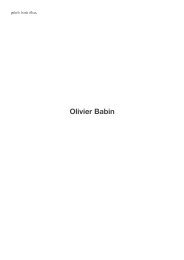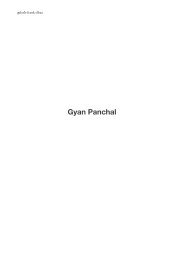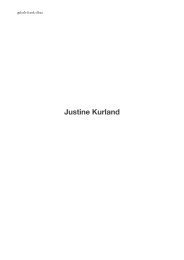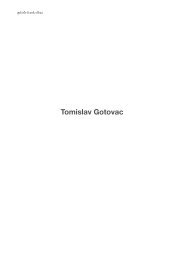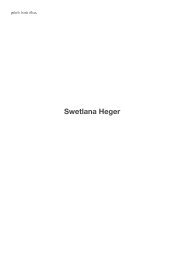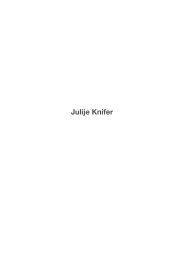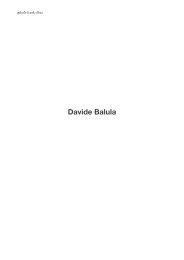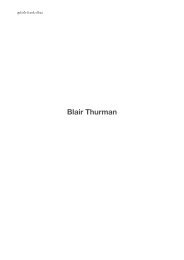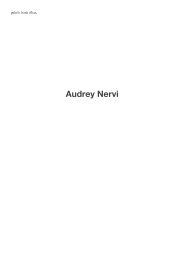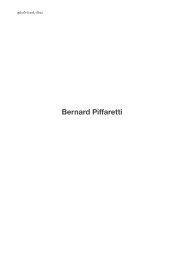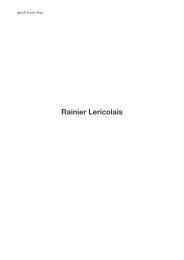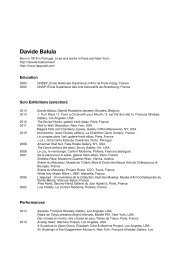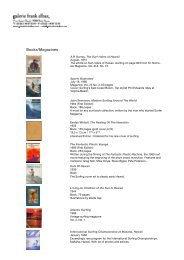Kaz Oshiro - Galerie Frank Elbaz
Kaz Oshiro - Galerie Frank Elbaz
Kaz Oshiro - Galerie Frank Elbaz
You also want an ePaper? Increase the reach of your titles
YUMPU automatically turns print PDFs into web optimized ePapers that Google loves.
<strong>Kaz</strong> <strong>Oshiro</strong>
<strong>Kaz</strong> <strong>Oshiro</strong><br />
Born in 1967 in Okinawa, Japan. Lives and works in Los Angeles, USA.<br />
Education<br />
2002 M.F.A., California State University, Los Angeles<br />
1998 B.A., California State University, Los Angeles<br />
Solo Exhibitions<br />
2008 <strong>Kaz</strong> <strong>Oshiro</strong>, Sorry We're Closed, Brussels, Belgium<br />
<strong>Kaz</strong> <strong>Oshiro</strong>, Clear Gallery, Tokyo, Japan<br />
2007 Common Noise, galerie frank elbaz, Paris, France<br />
Room Acoustics, Tokyo Institute of Technology, Tokyo, Japan<br />
Paintings and Works on Paper, 1999-2006, Las Vegas Art Museum, Las Vegas, USA<br />
New Works, Project Room, Yvon Lambert Gallery, New York, USA<br />
2006 Driving with Dementia, Rosamund Felsen Gallery, Santa Monica, CA, USA<br />
Subpar, Steven Wolf Gallery, San Francisco, CA, USA<br />
2005 Pomona College Museum of Art, Project Series, Claremont, CA, USA<br />
Drone, Rosamund Felsen Gallery, Santa Monica<br />
Room Acoustics, Tokyo Hipsters Club, Inart Gallery, Tokyo, Japan<br />
2004 Out-n-In, Rosamund Felsen Gallery, Santa Monica<br />
2002 Pet Sounds, Vol. 13: No Sound, More Alchemy, California State University, Los Angeles<br />
Pop Tatari (Curse of Pop Music), Rosamund Felsen Gallery, Santa Monica<br />
Group Exhibitions (selection)<br />
2008 Call + response, MUDAM, a series of events hosted by artist Candice Breitz Luxembourg<br />
One Way or Another: Asian American Art Now, Japanese American National Museum, Los<br />
Angeles, USA, curated by Melissa Chiu, Karin Higa, and Susette S. Min<br />
Less is less, more is more, that’s all, CAPC-Musée d’art contemporain, Bordeaux, France<br />
Some Paintings, Track 16 Gallery, Santa Monica, USA, curated by Doug Harvey<br />
Specific Objects, Johann König Gallery, Berlin, Germany<br />
2007 If Everybody Had An Ocean: Brian Wilson, Tate St. Ives, UK & CAPC-Musée d’art<br />
contemporain, Bordeaux, France<br />
Beneath the Underdog, Gagosian Gallery New York, NY, USA<br />
Forged Realities, Universal Studios, Beijing, China<br />
One Way or Another : Asian American Art Now, Berkeley Art Museum, Berkeley, USA<br />
2006 Red Eye: Rubell Collection, Rubell Family Collection, Miami, FL, USA<br />
One Way or Another : Asian American Art Now, Asia Society and Museum, New York, USA<br />
Smoke and Mirrors: Deception in Contemporary Art, University of Alabama, Birmingham, USA<br />
Banquet : A Feast for the Senses, Pacific Asia Museum, Pasadena, CA, USA<br />
Deaf « from the Audible to the Visible », galerie frank elbaz, Paris<br />
Tina B, Praha, Czech Republic, Curator : Pascal Beausse<br />
2005 Thing: New Sculpture from Los Angeles, UCLA Hammer Museum, Los Angeles, USA<br />
Re-form, Northern Illinois University Art Gallery, Chicago, USA
2004 Rock, Mark Moore Gallery, Los Angeles<br />
Giggles, Angstrom Gallery, Dallas, USA<br />
Nothing Compared to This, Contemporary Art Center Cincinnati, Cincinnati, USA<br />
2004 California Biennial, Orange County Museum of Art, Newport Beach, USA<br />
Boundary Creatures, Kansas City Jewish Museum, Kansas City, USA. Curator : James<br />
Brinsfield<br />
January 13-February 28, 2004, Swiss Institute, New York<br />
2003 2003 Summer Program, Apex Art, New York. Curators : Mitchell Algus, Michelle Maccarone<br />
Group Show, Rosamund Felsen Gallery, Santa Monica<br />
Redux, Luckman Gallery, California State University, Los Angeles<br />
2002 Group Show, Rosamund Felsen Gallery, Santa Monica<br />
2001 A Proper Aesthetics of the War, Gallery Zero One, Los Angeles<br />
Lazy Susan, Long Beach City College Fine Arts Gallery, Long Beach, USA<br />
I'm in This Show, Fifty Bucks Gallery, Los Angeles<br />
LA, CA, Newspace, Los Angeles
<strong>Kaz</strong> <strong>Oshiro</strong><br />
<strong>Kaz</strong> <strong>Oshiro</strong> réalise des reproductions en trompe l’œil d’objets usuels, qui sont en fait des<br />
peintures tridimensionnelles en acrylique sur toile. Les amplis utilisés en musique, les<br />
réfrigérateurs, les machines à laver et à sécher forment les humbles sujets de son travail.<br />
Hybrides, ils brouillent la frontière entre peinture et sculpture.<br />
Avec une attention plus que marquée pour le détail et un intérêt pour la vie quotidienne, les<br />
pièces défient les conventions de la représentation et nous demandent de porter attention<br />
comme de nous méfier de ce que nous voyons. À une époque saturée d’appropriation, les<br />
œuvres d’<strong>Oshiro</strong> se réfèrent au Pop Art, à l’art minimal et conceptuel sans tomber dans la<br />
servitude à ces courants. <strong>Oshiro</strong> dit essayer « [espérer] créer des formes post-Pop Art<br />
(peinture) qui juxtaposent Pop et Minimalisme au mouvement Néo-Geo, à l'Appropriationisme<br />
et au Photoréalisme, et les présenter comme une nature morte de ma génération. » Ces objets<br />
sont plus que de l’art sur l'art: les autocollants punk-rock et tout l’attirail de la culture populaire<br />
révèlent la lecture précise et juste que fait <strong>Kaz</strong> <strong>Oshiro</strong> de la haute et de la basse culture<br />
américaine.<br />
<strong>Kaz</strong> <strong>Oshiro</strong> meticulously crafts trompe l’oil replicas of common objects that are in fact threedimensional<br />
paintings made using canvas, stretchers, bondo and acrylic paint. Music<br />
amplifiers, dorm-room fridges, double-stack washer/dryers and scuffed credenzas form the<br />
humble subjects of his oeuvre. As hybrids, they blur the boundary between painting and<br />
sculpture.<br />
With their fanatical attention to detail and focus on everyday life they challenge the conventions<br />
of representation and ask us to look closer and distrust what we see and take for granted<br />
around us all day long. As appropriations in an age saturated with appropriations, they<br />
effortlessly reference pop art, minimalism, conceptual and finish fetish art – without being<br />
dominated by them. <strong>Oshiro</strong> says that he « hopes to create Post-Pop Art (painting) that<br />
juxtaposes Pop and Minimalism with the flavor of Neo-Geo, appropriation, and Photorealism,<br />
and present them as a still life of my generation. » But the objects are well more than art about<br />
art. Punk-rock stickers and other sub-culture paraphernalia reveal the Japanese born <strong>Oshiro</strong> to<br />
be an astute reader of American culture both high and low.
<strong>Kaz</strong> <strong>Oshiro</strong><br />
2007<br />
Common Noise, exhibition view, galerie frank elbaz, Paris, France<br />
Catalogue available
<strong>Kaz</strong> <strong>Oshiro</strong><br />
Wall Cabinet (Public Enemy)<br />
2007<br />
Acrylic and Bondo on stretched canvas<br />
51 x 77 x 25,5 cm / 20 x 30 1/3 x 10"<br />
Unique piece
<strong>Kaz</strong> <strong>Oshiro</strong><br />
Kitchen (Black Woodgrain)<br />
2007<br />
Acrylic and Bondo on stretched canvas<br />
Upper Cabine, 3 units, each : 76,2 x 38 x 30,5 cm / 30 x 15 x 12"<br />
Lower Cabinet: 91,5 x 236,2 x 62,2 cm / 36 x 93 x 24 1/2"<br />
Approximately : 236,2 x 236,2 x 62,2 cm / 93 x 93 x 24 1/2" installed<br />
Unique piece
<strong>Kaz</strong> <strong>Oshiro</strong><br />
Small Fridge<br />
2007<br />
Acrylic and Bondo on stretched canvas.<br />
62,2 x 47 x 50,8 cm / 24 1/2 x 18 1/2 x 20"<br />
Unique piece<br />
`
<strong>Kaz</strong> <strong>Oshiro</strong><br />
Microwave Oven (White #1)<br />
2007<br />
Acrylic and Bondo on stretched canvas.<br />
31,7 x 52,7 x 38 cm / 12 1/2 x 20 3/4 x 15"<br />
Unique piece
<strong>Kaz</strong> <strong>Oshiro</strong><br />
Trash bin #13<br />
2007<br />
Acrylic and Bondo on stretched canvas.<br />
50,8 x 101,6 x 50,8 cm / 20" x 40" x 20"<br />
Unique piece
<strong>Kaz</strong> <strong>Oshiro</strong><br />
Bumper #5<br />
2007<br />
Acrylic and bondo on stretched canvas<br />
160 x 15,25 x 17,8 cm / 63 x 6 x 7"<br />
Unique piece
<strong>Kaz</strong> <strong>Oshiro</strong><br />
Exhibition views, Yvon Lambert Gallery, New York, USA, 2007
<strong>Kaz</strong> <strong>Oshiro</strong><br />
Tailgate (OYOT)<br />
2007<br />
Acrylic and bondo on canvas<br />
135 x 45 x 2,5 cm, bottom edge 30 cm from wall / 53 x 17 7/8 x 1 3/4”, bottom edge 12” from wall<br />
Unique piece
<strong>Kaz</strong> <strong>Oshiro</strong><br />
Tailgate (OTA)<br />
2006<br />
Acrylic and bondo on canvas<br />
135 x 45 x 2,5 cm, bottom edge 30 cm from wall / 53 x 17 7/8 x 1 3/4”, bottom edge 12” from wall<br />
Unique piece
<strong>Kaz</strong> <strong>Oshiro</strong><br />
Microwave Oven #3 (Dead Kennedys)<br />
2006<br />
Acrylic and bondo on canvas<br />
50 x 29,5 x 32,5cm<br />
Unique piece
<strong>Kaz</strong> <strong>Oshiro</strong><br />
Fender Champ #3 (Maggots)<br />
2006<br />
Acrylic and bondo on canvas<br />
41 x 43 x 18 cm<br />
Unique piece
<strong>Kaz</strong> <strong>Oshiro</strong><br />
Wall Cabinet #9 (Pink eagle)<br />
2006<br />
Acrylic on canvas<br />
38 x 76 x 31 cm<br />
Unique piece
<strong>Kaz</strong> <strong>Oshiro</strong><br />
Cabinet #6<br />
2005<br />
Acrylic on canvas<br />
38 x 115 x 30,5 cm<br />
Unique piece
<strong>Kaz</strong> <strong>Oshiro</strong><br />
Cabinet #4<br />
2005<br />
Acrylic on stretched canvas<br />
77 x 101 x 22,5 cm / 30 1/8 x 39 3/4 x 8 7/8"<br />
Unique piece
<strong>Kaz</strong> <strong>Oshiro</strong><br />
Washer/Dryer #1<br />
2005<br />
Acrylic & bondo on stretched canvas, 2-part.<br />
Dryer: 109,2 x 68,6 x 71,1 cm / 43 x 27 x 28";<br />
Washer: 109,2 x 68,9 x 71,4 cm /<br />
43 x 27 1/8 x 28 1/8"<br />
Unique piece<br />
<strong>Kaz</strong> <strong>Oshiro</strong><br />
Cabinet #5<br />
2005<br />
Acrylic on stretched canvas<br />
38,1 x 115,24 x 30,5 cm / 15 x 45 3/8 x 12<br />
Unique piece
<strong>Kaz</strong> <strong>Oshiro</strong><br />
Cabinet #5<br />
2005<br />
Acrylic on stretched canvas<br />
38,1 x 115,24 x 30,5 cm / 15 x 45 3/8 x 12"<br />
Unique piece
<strong>Kaz</strong> <strong>Oshiro</strong><br />
Kitchen Project<br />
2004-2005<br />
Acrylic on stretched canvas<br />
L-shaped, left side: 215,9 x 405,15 x 65 cm / 85 x 159 1/2 x 25 5/8";<br />
right side: 215,9 x 257,2 x 64,15 cm / 85 x 101 1/4 x 25 1/4"<br />
Depth at center: 115,6 cm / 45 1/2"<br />
Unique piece
<strong>Kaz</strong> <strong>Oshiro</strong><br />
Microwave Oven #1 (Marilyn Manson)<br />
2003-2004<br />
Acrylic and bondo on stretched canvas<br />
40 x 59 x 40,5 cm<br />
Unique piece
<strong>Kaz</strong> <strong>Oshiro</strong><br />
Peavy Stack<br />
2003-2004<br />
Ancrylic and bondo on stretched canvas<br />
6 parts: 103 x 64 x 39 cm each<br />
Unique piece
<strong>Kaz</strong> <strong>Oshiro</strong><br />
Wall Cabinet #1 (I’ve been abducted)<br />
2003-04<br />
Acrylic on stretched canvas<br />
38 x 115,5 x 30,5 cm
<strong>Kaz</strong> <strong>Oshiro</strong><br />
Exibition view, Paintings and Works on Paper, 1999-2006, Las Vegas Art Museum, Las Vegas, USA
<strong>Kaz</strong> <strong>Oshiro</strong><br />
Exibition view, Paintings and Works on Paper, 1999-2006, Las Vegas Art Museum, Las Vegas, USA
<strong>Kaz</strong> <strong>Oshiro</strong><br />
Exibition view, Paintings and Works on Paper, 1999-2006, Las Vegas Art Museum, Las Vegas, USA
<strong>Kaz</strong> <strong>Oshiro</strong><br />
http://www.janm.or<br />
One Way or Another: Asian American Art Now, Japanese American National<br />
Museum, Los Angeles, USA, curated by Melissa Chiu, Karin Higa, and Susette S.<br />
Min<br />
Born in 1967, Okinawa, Japan<br />
Lives and works in Los Angeles, California<br />
We are living in an environment where we are surrounded by all kinds of objects;<br />
these objects often become second nature to us and soon we begin to care less<br />
about them. In that sense, objects exist just like the environmental noise that we are<br />
no longer sensitive to. John Cage and his friends have argued that even irritating<br />
ordinary noise can be valuable, like chamber music with its own will. Their argument<br />
recommends putting existing sounds on the same table and proposes that there is<br />
an anti-hierarchical sentiment within every sound in the world.<br />
I think I am recomposing objects as “noise” for my environment by using common<br />
painter’s materials. I’m interested in these objects I see that at first irritate, then we<br />
ignore. I remember and reformat them by using the painter’s vocabulary. Thus,<br />
ideally my objects may be placed in any condition at any place without identification<br />
that labels the objects as art. Hopefully, my works transcend the chaotic aspect<br />
within our ambience as does environmental noise
San Francisco Bay Guardian | Arts and Entertainment<br />
28/02/06 18:18<br />
Feb. 22 - Feb.28, 2006• Vol. 40, No. 21<br />
CLASSIFIEDS | RESTAURANTS | NUDE BEACHES | PROMOTIONS | BEST OF THE BAY<br />
calendar<br />
Club List<br />
Picks<br />
Music listings<br />
Event listings<br />
Stage listings<br />
Art listings<br />
Film listings<br />
Movie Clock<br />
Rep Clock<br />
news &<br />
culture<br />
alt.sex.column<br />
Techsploitation<br />
Burning Man<br />
Being There<br />
Talkback<br />
Alerts<br />
food & drink<br />
DineOnline menus<br />
Cheap Eats<br />
Without Reservations<br />
Meatless<br />
Edible Complex<br />
a&e<br />
Sonic Reducer<br />
Press Play<br />
Trash<br />
Full Circle<br />
Frequencies<br />
Super Ego<br />
just for fun<br />
SFBG Crossword<br />
Astrology<br />
Joke of the day<br />
This Modern World<br />
Dolezal cartoon<br />
classified<br />
Classified ads<br />
Personal ads<br />
web extra<br />
Ralph Nader<br />
MediaBeat<br />
Focus on the Corp.<br />
PG&E<br />
The FCC<br />
special issues<br />
Nude Beaches 2005<br />
The Sex Issue<br />
Bars and Clubs<br />
Summer Guide<br />
Superlists<br />
Project Censored<br />
connect to us<br />
Advertise with us<br />
Sponsored events<br />
Submit a listing<br />
Knockoffs<br />
<strong>Kaz</strong> <strong>Oshiro</strong> and Molly Springfield repurpose your junk<br />
By Glen Helfand<br />
› a&eletters@sfbg.com<br />
<strong>Kaz</strong> <strong>Oshiro</strong> and Molly Springfield may not know each other, but they<br />
both devote an inordinate amount of time to artworks that, on the<br />
surface, look rather ordinary. Their projects' deceptive nature, however,<br />
is the key to their appeal. His sculpture and her drawings evoke the<br />
curious relationships we forge with our stuff in a world of throwaways<br />
and eBay redistribution of the cast-off. Value is a taste-driven thing.<br />
The pairing of these two artists at the adventurous Steven Wolf Fine Arts<br />
gallery offers a means to explore, from opposite ends of a personality<br />
spectrum, a similar impulse to re-create mundane, manufactured objects<br />
with the human hand. <strong>Oshiro</strong> — born in Japan in the late '60s and based<br />
in LA, makes faux dorm fridges and audio equipment that are convincing<br />
relics from the life of a wannabe rocker. Springfield, who is in her late<br />
20s and lives in Washington, DC, painstakingly renders versions of<br />
photocopied pages from books; her pieces have a direct line to the mind<br />
of a lit or art history grad student. More than 20 years after artists like<br />
Richard Prince used the camera to coolly claim ownership of other artists'<br />
work, the practice of handcrafted appropriation addresses a pervasive<br />
yearning to give our prefab, but very personal, laptops and iPods warmth<br />
and fuzz.<br />
The three-dimensional nature of <strong>Oshiro</strong>'s work, along with its pop culture<br />
foundations, makes it the more immediately accessible of the two artists'<br />
projects. The spare installation of his objects in the gallery calls to mind<br />
an underfurnished warehouse loft more than an exhibition space. In one<br />
corner there's an unassuming stack of familiar white speakers — Bose<br />
Entertainment Sound System (2002) is its title. Nearby sits a small,<br />
lonely amp — Fender Vibro Champ #3 (2005). The materials listed for<br />
each of these are acrylic and Bondo on stretched canvas.<br />
Trashbin #9 (2005), an object that seems hijacked from a Wendy's<br />
dining room, almost abuts a pillar. There's just enough room to peer<br />
around and see that there's no back to the thing — you can see right<br />
into it, a vision of the familiar backside of a painting canvas stapled to a<br />
wood support. There are stains of cola-colored liquid pooled on the top of<br />
the bin. The piece is a convincing enough re-creation that guests<br />
attempted to dump plastic cups into it at the opening.<br />
http://www.sfbg.com/40/21/art_art_knockoffs.html<br />
Page 1 sur 3
San Francisco Bay Guardian | Arts and Entertainment<br />
28/02/06 18:18<br />
Letter to the editor<br />
Driving directions<br />
Link to us<br />
Shop Guardian<br />
about us<br />
Our masthead<br />
Editorial staff<br />
Business staff<br />
Jobs & internships<br />
This kind of art may be a one-liner, relying on the awe of being fooled by<br />
trompe l'oeil, or it may be simply an appropriation of movie<br />
prop–building practice. Yet there's something about the hollow interior<br />
of the rubbish bin that nudges the viewer toward a consideration of<br />
positive and negative space and the visual construction of the world we<br />
inhabit. What's plainly visible inside the backless pieces is the artist's<br />
signature. Wall Cabinet #5 and Small Fridge #5 (Black Flag) (both<br />
2005) — the latter with a reference to the punk band expressed in an<br />
artist-rendered sticker on the fake wood-grain appliance — are installed<br />
realistically against the wall. Their trickery is not visible, a strategy that<br />
introduces an existential sense of futility. All that time and effort, and<br />
for what<br />
Springfield's monochromatic graphite drawings invoke the same<br />
question. They're actual-size renderings of murky copy-machine output:<br />
Call her a photocopy realist. The sheets of thick rag paper, with a subtly<br />
rippled texture that is one of the few signals that this is "art," are hung<br />
from the wall with an upscale version of office clips. The show includes<br />
14 drawings, making it clear that hers is a committed practice that's<br />
dour and daft.<br />
These works gain their power from the way Springfield lavishes attention<br />
on the tiny though often legible typefaces. You can read them if you're<br />
so inclined. The selections are quite conscious, although the artist has<br />
been known to nab a random subject from the copy center floor to shake<br />
things up. Astute readers will note a spread from Elements of Style ("11.<br />
Don't explain too much"). The artist engages language as an aspect of<br />
conceptual art in the same way that, say, Eva Hesse did by making wall<br />
works that extended from the wall. In fact, one of Springfield's drawings,<br />
Hang Up (2005), includes an illustration of Hesse's similarly titled<br />
1965–'66 piece. The younger artist's act is as much a gesture of hero<br />
worship as an act of self-conscious art referencing. The land of academia,<br />
after all, is very much about deliberation.<br />
But Springfield also pays close attention to the gray areas of visual noise<br />
and distortion introduced by electronics, where there's no book and the<br />
copier has photographed itself. In these regions abstraction takes over.<br />
It's a gray area where the drawing becomes a transcendent, meditative<br />
site of ideas — all the better that the artist may have found it in the<br />
Kinko's recycling bin. *<br />
KAZ OSHIRO AND MOLLY SPRINGFIELD<br />
Through March 25<br />
Steven Wolf Fine Arts<br />
49 Geary, SF<br />
(415) 263-3677<br />
www.stevenwolffinearts.com<br />
SFBG Premium Classifieds<br />
http://www.sfbg.com/40/21/art_art_knockoffs.html<br />
Page 2 sur 3



